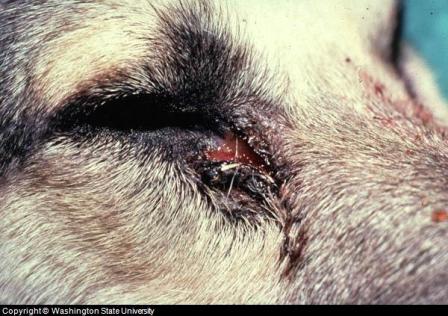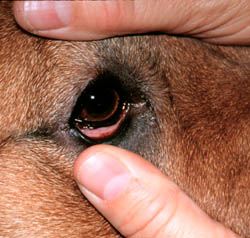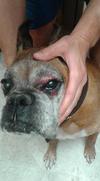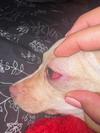Table of Contents
Causes | Conjunctivitis (Pink Eye) | Keratitis (corneal ulcer) | Homeopathic | Q&A
Summary:
Dog eye infection and signs in surrounding structures are common. There are various problems that can lead to dog eye infection. The most common form of it is called conjunctivitis (known as "Pink Eye") caused by bacterial, viral or allergens. Allergies can cause puffiness, watery discharge and redness, which can end up as conjunctivitis. Similarly "Dry Eye" is a condition in which dog cannot produce enough tears, hence leads to inflamed and redness in eyes. Corneal Ulcers are other reasons for eye infections, which if is left untreated can lead to loss of eye-vision, or even loss of eye. Some of the dog eye infections in the inner parts are anterior uveitis (problem on the inside of the eye) or glaucoma (redness on the white part of the eye, called the sclera).
Overview
The Vet should be seen for diagnosis, and can often tell the difference based on the location on the eye where the redness occurs.
Other parts of the eye that are commonly infected include the cornea (corneal infection, scratches, ulcers and keratitis). The cornea can also be damaged by a condition called dog dry eye or Keratoconjunctivitis sicca.
Common Causes of Eye Infections in Dogs
Causes of dog eye infection includes:
- Bacteria
-- ulcer/keratitis or corneal infection
-- pinkeye (conjunctivitis) - Viruses like the Herpes virus
- Glaucoma
- Foreign material / debris
- Irritants and allergens in the eye
- Lyme disease
If your dog’s eyes appear red or inflamed, if she has unusual drainage from her eyes (some moisture in the eyes is normal and healthy; you will know what is normal for your pet), or if she seems to be having trouble seeing or to be especially sensitive to the light and has been pawing in eye a lot lately, see your veterinarian for a diagnosis. Treatment for a dog eye infection is either topical via drops or ointment, prescription or homeopathic. (see below for specific types of eye infection and related treatment options).
Eye infections may become chronic if not treated and can cause permanent damage if neglected.
If you expect allergies or something in the environment are the cause, you can try an over the counter saline solution as an eye wash. It should be remember that allergens cause inflammation (redness and irritation) but it also can cause puffiness in eyes. If you see no improvement after 2 days then see your veterinarian. If you suspect an eye tumor see our guide on canine eye tumors.

Source: Washington State University
Specific Causes of Canine Eye Infection
Dog Corneal Infection or Ulcer (Keratitis)
The outer lining of the eye is called the cornea. It's role is to cover the iris (the colored, circular part in eye which contracts to control the amount of light entering eye) and the pupil (it's the part which widens in dark and narrowed in light), protecting the interior of the eye. If the cornea becomes scratched or if some type of other defect forms due to a diseases such as dog dry eye or pannus (a degenerative disease of eye, in which fine blood vessels grow on the clear corneal surface), it can become infected with bacteria, causing a condition called canine keratitis (also called a corneal infection). If the bacteria isn't treated early, the infection becomes deeper, causing a canine corneal ulcer that could rupture the eye globe, resulting in loss of eye vision and may require dog eye removal.
Dog Keratitis (Corneal Ulcer) Treatment
Treatment for a canine corneal ulcer involves the use of a topical antibiotic such as ofloxicin or ciprofloxacin. If your dog is in pain, then a specific medication to make your dog comfortable may also be prescribed. One approach to combat bacteria is to use a topical serum that is actually made from the dog's own blood. Treatment requires frequent evaluation by your veterinarian and treatment that can last weeks to months.
Dog Conjunctivitis (dog pink eye)
Dog conjunctivitis or dog pink eye is the most common dog eye infection. It is an inflammation of the membrane covering the inside of the eyelids and the front of the eye also called the mucous membranes of the eye. It often just affects one eye, although it can affect both. The eye becomes red and inflamed. There may be clear or mucous discharge from the eye. It is usually caused by viruses, bacteria and allergies. Less often, it may be caused by parasites.

is the most common type of dog eye infection
A common primary cause of canine conjunctivitis is chronic irritation and/or exposure resulting from anatomical problems of the lids (entropion, ectropion) or eyelashes (e.g., distichia, trichiasis). Irritation may also result from nasal folds and exposure in brachycephalic breeds, as well as exposure to chemicals, wind and dust.
Canine conjunctivitis does not cause a change in vision. Pain is not associated with the disease and redness is moderate to minor. A common primary cause of canine conjunctivitis is chronic irritation or exposure resulting from the incorrect way the eyelids (distichia, trichiasis) or eyelashes functioning. Redness may also be caused by nasal problems and exposure to environmental toxins such as chemicals, wind or dust. The dog may be seen pawing in eye a lot.
Treatment for Conjunctivitis in Dogs
Conjunctivitis is usually treated with medicated (antibiotic) eye drops. These are administered several times a day and will lead to a dog conjunctivitis cure. In addition, the cause of the conjunctivitis must be treated. This may mean oral antibiotics will be prescribed, or allergy medication given.
An approach you can try at home is to clean the discharge from your dog's eyelids. Wet a soft, clean cloth or cotton ball with lukewarm water, squeeze it out and gently wipe away the discharge from around each eye that is affected. Repeat twice a day or as often as needed. You can also try a scrub such as an over the counter eye scrub such as Eye Clear. Eye scrubs are pH-balanced and may cause less stinging than water.
Another approach is to help your dog shed some tears. Eye scrubs help keep the lids clean, you'll also want to wash the surface of the eye. A good way to do this is with artificial tears, which can help wash away particles that may be causing the problem.
For added relief try applying a compress. Covering your dog's eyes with a damp, warm compress can be soothing. Apply for 5 minutes. Rinse the cloth first is applying to more than one eye.
Grooming can help prevent eye irritants by keeping hair out of the eye. Hair around the corners of the eye can cause canine conjunctivitis. Brushing the hair away from the eyes can help as well.
Keratoconjunctivitis sicca (Dry Eye)
Keratoconjunctivitis sicca is a condition in which there is inadequate production of tears in the eye. The eyes are too dry and the corneas can be damaged. There is also the risk of ulcers (sores) on the eye. In some cases, this is a chronic infection, requiring long-term treatment.
Treatment for Keratoconjunctivitis Sicca
Keratoconjunctivitis sicca is treated with artificial tears (eye drops that are formulated to resemble the composition of natural tears), tear stimulants, and anti-inflammatory eye drops. Oral anti-inflammatory medications may also be prescribed.
Canine Uveitis
Uveitis is an inflammation of the interior or inside of the eye. Symptoms include redness of the eye, a cloudy appearance, or may appear the eye can appear bloody on the inside. The dog eyes may also be sensitive to light (photophobia), have blurred vision, and be experiencing some eye pain. Blindness can occur if it is not treated.
Causes include infectious diseases such as blastomycosis or leptospirosis, or other viral, bacterial, fungal, protozoal and rickettsial causes.
Canine uveitis diagnosis is performed in the office with an ophthalmascope. If the vet suspects a dog eye infection, then the vet may opt for blood or urine tests to rule out infectious organisms as a potential causes.
Uveitis Treatment for Dog Eye Infection
Uveitis is treated with glucocorticoid steroid eye drops, such as betamethasone, dexamethasone, or prednisolone. Oral steroids, such as prednisone, may also be prescribed.
Eye Ointment Use
Here are some tips to help you get more out of your eye ointment:
- Eye ointment comes in small bottles because treatments usually do not require that much medicine. Having leftover ointment is also not a good idea as these products can easily become contaminated.
- Follow instructions! If the instructions say use one drop, then use one drop. One drop is equal to a small grain of rice.
- If using multiple eye ointments or medications, wait at least five minutes between applying each dose. If given close together in timing, the second ointment might wash out the first, reducing effectiveness.
- To avoid your dog backing away during treatment, consider giving the medication when the dog is positioned in a corner of a room. Treats are also helpful by having a treat in one hand and be ready to give the medication with the other. Ointment is preferred over drops as it is easier to get an ointment on the pink tissue in the eye.
Homeopathic Dog Eye Support
After checking with your veterinarian, natural approaches to dog eye care contain herbal tincture that can provide additional support for the eye during recovery from disease and to prevent eye infections in dogs as well as improve general eye and visual health. It is NOT a substitute for prescription eye care that addresses specific infections.
Common ingredients in homeopathic dog eye home remedies include:
- Arctium lappa (Burdock) - cleansing and eliminating herb and is excellent at detoxifying the tissues and removing unwanted substances from the body.
- Rosmarinus officinalis (Rosemary) is well-known as a topical antiseptic/disinfectant, pain-relieving herb with anti-inflammatory effects.
- Chelidonium majus is used to boost the immune system, combat infections, sharpen sight, promote healing and act as an analgesic (pain killer).
- Filipendula ulmaria (Meadowsweet) Has astringent, antiseptic and anti-inflammatory properties and is excellent for soothing and healing infections of the eyes and conjunctiva.
A good commercial source for these and similar herbal treatments is Pet Alive for eye infection. Note that herbal remedies are for added support, speed healing and prevent future dog eye problems. They are are not considered to be a specific cure.
Ask Our Vet A Question And We Will Answer It For Free
Have a Dog Eye Health Related Question For Our Veterinarian?
Do you have a dog eye infection or eye health related question for our Veterinarian? We'll answer it for free! Please include information such as eye appearance, if the condition can be found in both eyes, dog age, sex, breed, medical history, symptoms, diet, changes in behavior and medications.
The quality of your response will be greatly improved if you can add a picture of the canine eye problem. Just use the upload button below.
We will do our best to get back to you quickly (depends on how many questions we receive each day). If you do require an immediate response we suggest using this online dog veterinary service that is available now.
Other Dog Eye Related Reader Questions and Answers from our Vet
Click below to see contributions from other visitors to this page...
Dog Eye Infection That Will Not Heal 




Reader Question: Lingering Dog Eye Infection
I have a Bichon that is 14 years old and that has had an eye infection for a long time. I have treated …
Swollen Raw around Dog Right Eye 



Reader Question: Help for a Swollen Irritated Dog Eye
My 11 year old boxer has been scratching his right eye all night until it is raw and swollen. …
Puppy With Red Eye After Play With Another Puppy Not rated yet
My 8 month old puppy was playing with his brother pup a bit rough and then we noticed a little redness in his eye at the outer corner. The next day there …
Dog Eye Infection or Something Else? Not rated yet
The area around my dog’s left eye started getting crusty a couple of days ago. After I cleaned it, I could see some swelling and that his eye was red. …
Dog Eye Discharge and Sensitivity to Light Not rated yet
My German Shepard, weeniepit mix tan and white one year old has a lot of eye discharge and sensitivity to touch and light. I just got her less than 24 …
Mucocutaneous Treatment Not rated yet
My dog has mucocutaneous can I buy the medicine at a store.
Editor Comment
Hi Belinda,
I’m sorry to hear that. Mucocutaneous pyoderma is a bacterial …
Loss of Dog Sight Not rated yet
Reader Question: Cause of Dog Vision Loss
My 13 year old Golden Retriever had gradual loss of sight over a six month period. Eyes appear to be hazy. …
Dog Eye Infection Not Responding to Treatment Not rated yet
Reader Question: Dog Eye Infection Not Responding to Initial Treatment
My Jack Russell has swollen eyelids since 10 days ago. I noticed her left top …
Third Eyelid Elevation and Dog Dry Eye Not rated yet
Reader Question: Dog Third Eyelid Elevation and Dry Eye
Hi Jennifer,
My dog Maddie is eleven years old, a cross boxer/Dalmatian. For the last …
Dogs Eye Infection Turned Blue Not rated yet
My 13 year old male shih Tzu got an eye infection, been treating it but has not helped. Now his eye has turned a foggy blue color.
What does this mean? …
Should Dog With Red Eye Go To Specialist? Not rated yet
Reader Question: Is It Time To Take My Dog For A Second Opinion?
My golden retriever is having Red Eye problem . Her right eye is Red while her …
Dog Rubbing Eye Not rated yet
I have a Great Dane. I have recently noticed that my dog is continuously rubbing his eye and has erratic blinking of the right eye. I have tried to thoroughly …
Dog Eye Infection Not rated yet
Reader Question: Dog Eye Infection
I have a two year old female Westie, she gets mucus that is thick and it covers her entire eye ball. It's only …
References for Dog Eye Infection
Diagnosis and Treatment of the “Red Eye”
Ron Ofri, DVM, PhD, Diplomate ECVO,
Koret School of Veterinary Medicine
Hebrew University of
Jerusalem, IL
Glaucoma - The Updates
Simon M Petersen-Jones DVetMed PhD DVOphthal DipECVO MRCVS
Associate Professor
Department of Small Animal Clinical Sciences
College of Veterinary Medicine
D-208 Veterinary Medical Center
Michigan State University
East Lansing, MI 48824






